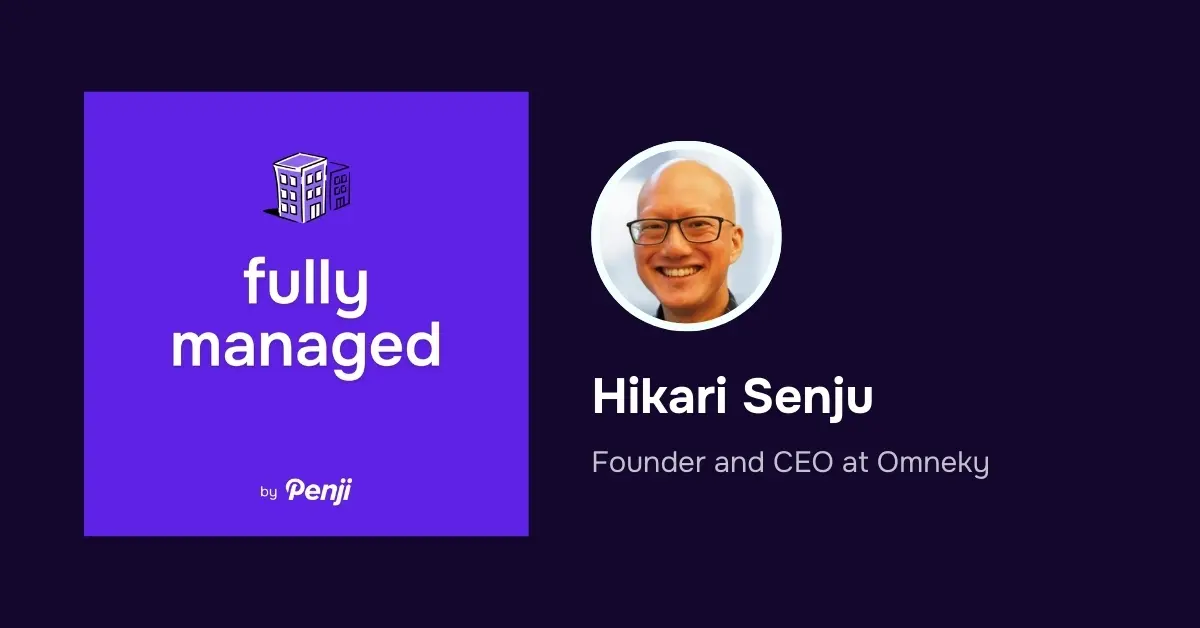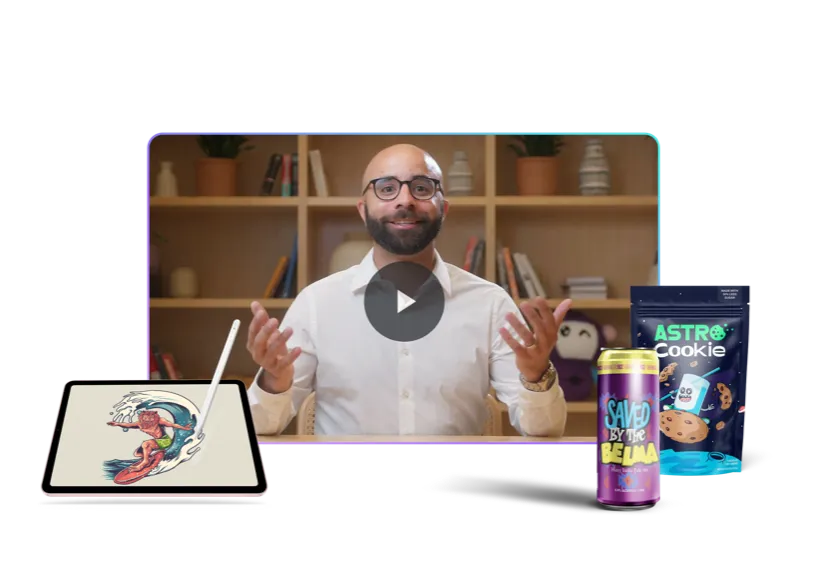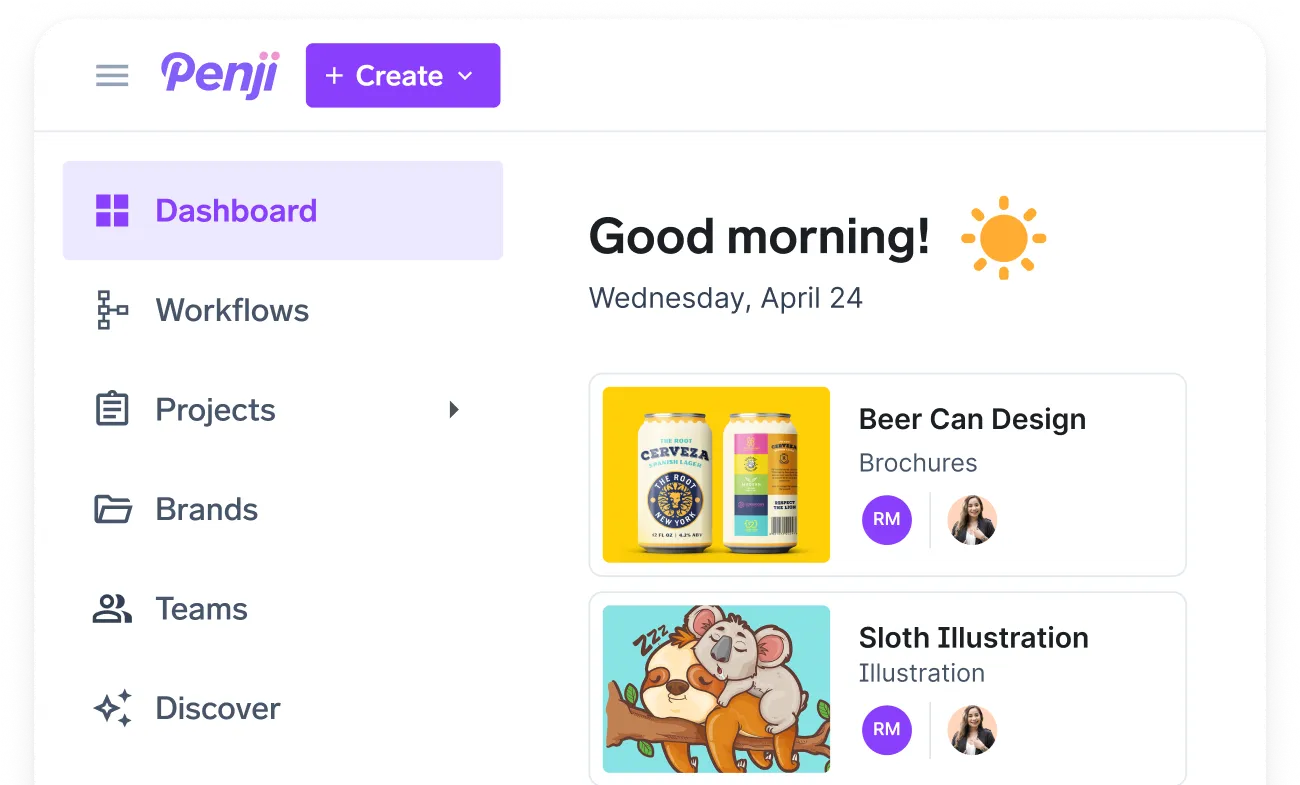
Welcome to The First One Hundred Podcast
Daniela: Hello, everybody. Welcome to the first one hundred podcast. This is where we explore the journey of entrepreneurs, business owners, agency leaders, while they all share with us the strategies, the challenges and triumphs that have led them to secure those first one hundred customers. I’m your host, Daniela, and I’m Peggy’s partnership coordinator. I’m joined here today with a very special guest, Hikari Senju from Omniki. Hi, Hikari.
Hikari Senju: How are you doing, Daniela? It’s great to be here.
D: It’s great to have you. Just so that we can get started for anybody that doesn’t know about OmniKey, who doesn’t know about you, can you tell us a little bit about yourself and about your business?
HS: Sure. So OmniKey is an omni-channel creative optimization and generation platform. So if you’re running ads on various social media platforms and display platforms and streaming platforms and you need to create marketing assets and advertising assets for those platforms and then analyze performance of those assets and generate new variations of content, we’re the workflow tool for that. And our customers have seen a two X increase in ROAS from utilizing our platform and in around eight times efficiencies in terms of time and costs.
D: Interesting. So you guys are basically sort of using AI to leverage content marketing and advertising, right? To make it a lot faster for business owners.
The Evolution of AI in Ad Tech
HS: Yeah, so I think we were the first mover in ad tech for generative AI. I founded it back in twenty eighteen with this product. Definitely the product has changed a lot since twenty eighteen, but we were offering the early GPT models with our platform back in twenty eighteen, nineteen. GPT comes out, the first version of GPT comes out in twenty eighteen. And we were doing early insights and analytics with computer vision back in twenty eighteen as well. So the core offering of the company hasn’t changed since we’ve founded the company, but definitely underlying power and technological capabilities have advanced significantly.
D: So how has the AI that you’ve been using in OmniKey since you got started in twenty eighteen been changing to create generative creative content?
HS: Yeah, so the first version of the product was basic computer vision models. There’s a cat in the model. There’s a cat in the image. There’s not a cat in the image. There’s a dog in the video. There’s not a dog in the video. Is this correlated with increasing click-through rates, increasing conversion? Is there any kind of connection with that and conversion rates? Then using early fine-tuned, so the early days of GPT-II is you could take an embedding from hanging phase so that you can fine-tune that to generate copy that was relevant to the brand. That was the early versions of OmniKey. All the generation side was an LLM to generate copy powered by fine-tuned GPT-II models and fine-tuned GPT-II embeddings. And then we would recommend stock photos. So that was version one. And then since then, obviously, there’s a lot more LLMs now that power the copy generation. The insights and the likes of, it’s not just basic computer vision anymore, but using multimodal AI to discern trends and images and video, discern creative elements within images and video to get better predictive insights. And then, you know, generating product photos also, you know, using fine-tuned diffusion-based models to generate hyper-realistic product photos, you know, fine-tune the model on product photos of brand styles and then, you know, your locations or clothes to generate hyper-realistic product photos. And then separately, an LLM fine-tuned on the brand voice. So we’re generating copy content in the voice of the customer. So the technology has advanced significantly since we launched, but the basic idea of using analytics and insights to power personalized content, that hasn’t changed. And our tool is just more capable and powerful because of the underlying changes. And that was kind of the idea and the thesis when I founded the company back in, thinking about the company in the company in the company in the company in the company in the company in the company.
D: I mean, I was also like, I was very young in twenty seventeen, twenty eighteen. So maybe I wasn’t like in the tech game, but I don’t remember AI being as big as it was back then. So, you know, the fact that you had the vision to see that this was something that had a future is incredible to me. I mean, I think people really do not, not everybody has that sort of vision to see where the future is headed.
HS: I think there’s an element of being right place at the right time. I studied AI computer science at Harvard and with a focus on machine learning. I was taking a lot of AI coursework at MIT. I’d also gotten to MIT and I then separately, you know, I grew up in a kind of a technological family. My grandfather worked at IBM and so kind of had this intuition regarding Moore’s Law, the exponential rate, the exponential rate in which technology improves. You know, now they’re talking about, you know, Jensen Wong’s Law as well in terms of even more accelerated capability advancements in AI. And so just kind of developing the intuition that, like, you know, that technological improvement is not linear. It’s exponential. And so therefore thinking that this was going to come sooner than later, this technology that we’re seeing today. And the second thing, I think, is having this kind of orientation around generative art and generative creative in general. My dad’s an artist, and he’s a painter. And so when I saw the early generative models, now as generating artwork, I got very excited about technology because immediately saw the applications of generative art in advertising. You know, I think advertising is one of the biggest commercial use cases of artwork. And so, you know, if you can generate art, you can generate ads. And so then immediately seeing that application in advertising, that’s really what got me excited about, you know, starting this company in the advertising space, you know, before many others did.
The Early Days of OmniKey
D: That’s interesting. So that’s what motivated you to start OmniKey. How was those, like, how did that sort of happen? How were the beginnings of the business, you know, back like when everything was a lot smaller?
HS: Yeah, I mean, this, you know, this podcast is on the first hundred days. So it’s, yeah, gosh, yeah. Just as you’re saying, the earliest days, nobody really took AI seriously in the sense that people thought AI was vaporware. You tell somebody that you’re AI and they just wouldn’t believe you. It just was like, sure, maybe in the next decade, maybe a decade from now, what you’re saying will happen, but it’s not anytime soon. And so definitely the challenge of educating the market on this technology. And also building a product in terms of this capability, those are two challenges that we face in early days. And I think you just need to find enterprising entrepreneurs and CEOs and CMOs that are willing to take a risk on you and take a chance on paying a little bit of money to implement this tool. We started, therefore, in twenty eighteen. Our very first product was analytics product. So it wasn’t on the generative side because they were like, oh, generative capabilities. I have designers on my team. I don’t necessarily need creative because I like the creative that my designers produce. But, but, you know, insights, if you get some good insights analytics with with the data that I’m sitting on, then, you know, that that’s a net positive. And, you know, we’ll only pay a small amount of money for that. And so that’s what was actually our very first product was an analytics product. We’d use computer vision to tag different elements in the creative. And then we’d find correlations between those elements. And it conversion rates depending on where in the funnel the customer was and the audience. So top of the funnel, certain audience, these are the creative features that are driving higher conversion rates. And you could actually kind of like filter out the results and the insights based on the audience and like the name of the campaigns and ad sets. And so that was the very first product. That product, that product was, you know, didn’t necessarily get to a hundred users, that product in and of itself, but did help start the business, get revenue, get data, which is the most important thing for generative AI companies, get access to data. Yeah, especially in ad tech. I think, you know, there’s, you know, because ad tech really starts, humming when you connect to the distribution channels and data, because all the outside of that, you just kind of a content creation tool, which is cool, but it’s not really, you know, ad tech. And so getting access to the distribution networks, the ad platforms, any access to advertising data, that was critical part of selling analytics tool. And then. And then in the year we launched our first generative tool, which was powered by GPT-III. And that was a tool that you can generate copy. And that was really how we got our first hundred users.
D: That’s wow. So it was essentially like a two-year journey into getting that hundred user sort of milestone, right?
HS: Yeah. It was a long incubation period. I mean.
D: It was long journey. I mean, yeah, it was definitely experience again. Those were, those were a very, yeah, those were very tough first couple of years. I can imagine. Yeah. Because I guess like it’s also, you were working with something that was so, I think nowadays, if you want to start an AI company, people would be a lot more receptive to it. But at the time you were working with something that was so abstract and, you know, like most people didn’t really believe in it probably, or didn’t understand it or like didn’t see the value in it. So just having to get through the hurdle of, of showing people and educating them that this is something that is, is good. It’s worth it. Right. You need to understand it and it’s going to help you so much.
HS: Yeah. Yeah. And the analogy I like to use with the team was it’s a bit like surfing. It’s like, you know, you see a swell coming, you know, it’s going to you got to catch this wave. It’s better that you’re too early, you know, out of space and you can kind of wait a little bit more to catch the swell and catch the wave than to be too late and not be able to catch the wave at all. And so, yes, we, you know, we were a little bit too early. The swell was very small at first. Very few people could discern there was a wave coming potentially. I mean, obviously, I think there were people who did see it as well, but there weren’t as many. But now we’re riding this wave, and it’s thanks to the legwork we put in for the first two, three years, just grinding it out, talking to customers, developing an expertise in advertising, developing an expertise in creative workflows. and enterprise creative workflows. And then, and then now, you know, we’re now harnessing all this, this knowledge we’ve developed to, you know, growing the market.
COVID-19’s Impact
D: I’m curious, was any of your growth affected by COVID, whether it was negatively or positive? I think I’ve spoken to people who have had situations where like COVID completely destroyed their business and they have to like remodel, reshape everything because of the nature of whatever business it was. And then I’ve heard people who are like, no, COVID was great for me because people were spending so much more time at home. And my, you know, like my product was for at home, people who were doing remote work or something. How was that for you?
HS: Yeah, COVID was it was an inflection point for us in several ways. And that was really, you know, that was it was it was very tough. It was it was tough for many people. It was but it was it was very in terms of the company, it was it was very like number of factors came together during that period. I mean, first of all, suddenly there was demand for digital advertising. So every company that was that was, you know, brick and mortar had to figure out digital strategy, right? So even if you weren’t running digital ads before, now you suddenly needed to figure out how to run digital ads, how to create content, and there was suddenly an influx demand for digital advertising. There was a whole new cohort of businesses that were looking to learn and create cheaply create and test advertising on social and online. So suddenly there was a demand for our product. During that period, also GPT-III comes out. So suddenly the technological capabilities of our tools also significantly increased. So the capability of our tool had suddenly had kind of a step change in capabilities. And then suddenly the demand for advertising and advertising tools also increased, especially on the SMB side, which is where a lot of startups start, increased in a step change as well. So those two factors were very key for us in terms of being our first hundred customers. And then uniquely also, I think composition wise in the team, this is not as discussed in terms of, I haven’t really discussed this as much in terms of the history of the company, but we utilize a lot of college interns during this period. So the price of labor, especially we’re a bootstrap company for the first couple of years, right? Because it’s AI, nobody really believes in AI. And so you’re kind of scrapping it out initially, very resource constrained. But suddenly you had all these students who are very smart, very knowledgeable that are stuck at home. And yes, they had to zoom into class a couple hours a day or a couple hours a week, but they had a lot of time and they’re looking to make money as well. And so we hired dozens of interns to help us with sales, to help us with marketing, to help us with customer success. And our team grew through essentially like an army of college interns from many of the top schools from really just myself and a handful of engineers to a team of forty, fifty people that were all like kind of part time interns. And so it was like literally these college interns making a commission on getting paid money on reaching out to customers and reaching out to leads. Technology being capable of selling this, of, you know, delivering generative content, and insulin demand for digital advertising, those three things resulted in quickly the fast growth of that company, of OmniKey, during, during.
D: That’s incredible. I mean, you were sort of able to leverage that to keep OmniKey growing and stable, I think. We saw a lot of businesses like startups and small businesses kind of fall apart during COVID. I remember in my like, I was in college when it all happened. And I remember there was like a bar near my house that was like popping, I guess at the time and they, once COVID hit, they decided to start doing like delivery cocktails, but it didn’t really go very well because nobody wanted to get delivery for like a margarita and the place ended up closing down. And I was like, well, yeah, because that’s the type of business that’s very like interactive, you know, it’s, it’s really difficult to move a bar from like in person too.
HS: It was tough time for restaurants for sure. Yeah.
D: Yeah. Yeah. So it just kind of like, I think it’s interesting because you see such a big contrast with businesses such as yourself that are very like tech driven, AI driven for more traditional type of businesses. And I think it really points towards how the future is moving as well for things like advertising, right? It definitely has changed. And I think data is very big now. So much more important than it was like, I think I guess data has always been important, but I think now it’s like even more poignant.
HS: Yeah, for sure. I mean, I think people are still realizing how powerful data is because you have these elements that are powered by all this data and you’re like, you know, before you were just sitting on this data and you could get, you know, occasionally getting a good insight based on these analytics tools. But, you know, it’s still very hard to wrangle. You had to hire hard data scientists and you had to spend a lot of money trying to extract these insights from the data. Kind of massage data to get something useful. But now you have these LLMs that just, you feed it data and it just like outputs magic, right? And so, yeah, people are really seeing that the one-to-one mapping of data to value so much more clearly now with large language models. Yeah. Yeah. And then in terms of, I think there, you know, post-COVID, they were talking about kind of this, or during COVID, they were talking about this case-shaped recovery, right? So you had, you know, AI, online, the internet-enabled, virtual-enabled businesses, like, grow fast, but then kind of, you know, brick-and-mortar businesses struggling during COVID, and then even a little bit. And so. Like, it’s been a, you know, a tale of two cities. And I think that it continues to be a feature, I would say, of the general economic growth story overall, I would say, is that kind of that continued kind of narrative in some ways of continued hyper growth of of of internet and technology businesses and generative AI companies and semiconductor companies and and then kind of the and then and then maybe perhaps a slightly different narrative when it comes to non tech enabled businesses.
D: Yeah, I think non necessarily not a a business that’s not necessarily tech driven or that’s more traditional like a more traditional model more like what we’re accustomed to I’ve seen a surgence of of having that interest in more tech related content and data and you know trying to optimize a lot of things whereas like before everything was a lot more traditionally oriented I think now we see more of that correlation between the tech world and like you know a random restaurant or like a small business because social media has also become very important. Content marketing has gotten really big. Generative AI ads in general. All of these things are sort of really changing the advertisement game.
HS: Absolutely. Yeah.
The Future of OmniKey
D: So I also wanted to ask, since you guys have been since twenty eighteen, that’s about six years, five years, right?
HS: Yeah, it’s getting there. It’s getting there. It’s getting up there.
D: What is in store for the future of OmniKey? What have you guys got planned that’s interesting or fun?
HS: Well, you know, the goal is and generally takes about ten years to IPO a company on average, you know, and so we’ll see. I mean, that’s the goal. Hopefully we can do it in ten years and the next five years. But, you know, also it’s a milestone that we’ve survived this far as well. I mean, most companies do not survive two years and most startups don’t survive two years. And, you know, we’ve operated, we’ve we’ve operated this company both during lean times and boom times, you know, catching numerous waves and, you know, like there’s the big GRVI, but there’s smaller waves as well. And kind of, um, so, you know, whether that is COVID or post COVID or, you know, the, the, you know, just like every year there’s like kind of the story. Right. So, um, Yeah, and so for us, it’s continuing to focus on this core focus from day one, which is data-driven creative. How do we use AI to help businesses democratize growth? So how do we help businesses tell their story, connect with customers with data-driven creative content? And so along that focus for today and as of September eighteenth, we released hyper-realistic product photo generation. So you can fine-tune a model on a product photo and on a brand style, and it’ll generate hyper-realistic product photos in the style of the brand in any setting. You can prompt it in any setting. It’ll generate that image. You don’t need to do an expensive photo shoot or video shoot anymore. We do it with AI, and so that means more content, faster iteration, more higher conversion rates, and faster cycle times in terms of testing content. We’re generating creative briefs, ideations, mood boards, providing insights with very rich insights in terms of creative for our customers on an omnichannel basis. Those are some of the capabilities we’re offering today. But in the future, more agent driven advertising, more autonomous advertising, I think Today, we’re kind of in a co-pilot situation with AI advertising. You have a human in the loop working with an AI to create content. But I think in the near term, future will be more full self-driving, fully autonomous systems where an AI is generating content on its own and kind of running the content because that cycle time is even faster and more can be more efficient. And yeah, people make a lot of mistakes. AI makes mistakes and people also make mistakes. But as the rate of mistakes that AI makes gets lower, then at some point, a full self-driving system makes more sense. And so that transition is probably going to happen. We’re going to have products like this soon, but that overall transition will probably happen over the next couple of years. And yeah, I think continuing to focus on you know, other ways we can democratize growth and help businesses connect with customers with personalized generative ads.
D: So there’s a lot of exciting stuff coming for you guys. It’s been great talking to you and hearing about Omnikey. Just before we close this call, I wanted to give you the space to tell everybody where to go and find you. If any of our listeners want to use your services, they want to ask you any questions, they’re curious about anything, the floor is yours.
HS: Yeah, so check us out at www.omnikey.com, O-M-N-E-K-Y.com. Also follow us on socials, at Omnikey, whether it’s on X or on Meta, on Facebook, Instagram, on LinkedIn, on YouTube, on Threads. You can follow me at H-I-K-A-R-I-S-E-N-J-U on X. And you can also feel free to send me an email at hikari.omnikey.com.
D: Awesome. Yeah, I will be adding those links to the description of this so that people can go ahead and find you. Thank you so much for doing this.
HS: Thank you, Danielle.
D: It’s been great having you for everybody watching. I’ll see you guys on the next episode. Bye.









